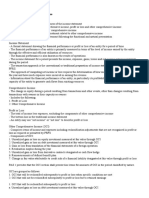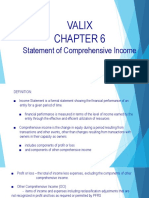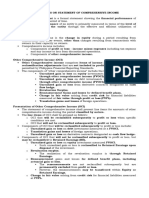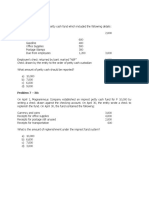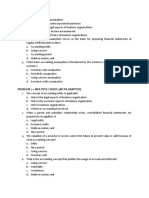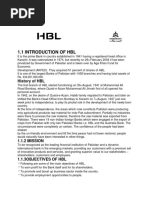0 ratings0% found this document useful (0 votes)
28 viewsChapter 5
This document contains 10 multiple choice questions related to accounting concepts including:
1) The definition of changes in equity during a period.
2) The components that are included in comprehensive income.
3) The definition of profit or loss.
4) The definition of other comprehensive income.
5) The two-statement approach for presenting comprehensive income.
It asks the reader to identify exceptions and components of other comprehensive income and expenses presented by nature and function.
Uploaded by
Jao FloresCopyright
© © All Rights Reserved
Available Formats
Download as DOCX, PDF, TXT or read online on Scribd
0 ratings0% found this document useful (0 votes)
28 viewsChapter 5
This document contains 10 multiple choice questions related to accounting concepts including:
1) The definition of changes in equity during a period.
2) The components that are included in comprehensive income.
3) The definition of profit or loss.
4) The definition of other comprehensive income.
5) The two-statement approach for presenting comprehensive income.
It asks the reader to identify exceptions and components of other comprehensive income and expenses presented by nature and function.
Uploaded by
Jao FloresCopyright
© © All Rights Reserved
Available Formats
Download as DOCX, PDF, TXT or read online on Scribd
You are on page 1/ 3
CHAPTER 6:
Problem 6 – 5:
1) It is change in equity during a period resulting from transactions and other events, other
than those changes resulting from transactions with owners in their capacity as owners
a) Profit or loss
b) Comprehensive Income
c) Other Comprehensive Income
d) Share Capital
2) Comprehensive income includes
a) Profit or loss
b) Other comprehensive income
c) Both profit or loss and other comprehensive income
d) Neither profit or loss nor other comprehensive income
3) It is the total of income less expenses, excluding other comprehensive income.
a) Comprehensive income
b) Profit or Loss
c) Accounting income
d) Economic income
4) It comprises items of income and expense, including reclassification adjustments, that are
not recognized in profit or loss as required or permitted by PFRS
a) Comprehensive income
b) Other comprehensive income
c) Profit or loss
d) Retained profit
5) What is the two – statement approach of presenting comprehensive income?
a) A comparative statement of comprehensive income
b) A combined statement of comprehensive income and retained earnings
c) A combined income statement and a statement of changes in equity
d) A separate income statement and a separate statement of comprehensive income
6) Other comprehensive income includes all of the following, except
a) Gain and loss arising from translating the financial statements of a foreign operation
b) Gain and loss from debt investment measured at fair value through OCI
c) Gain and loss on hedging instrument in a cash flow hedge.
d) Dividend paid to shareholders
7) Which component of other comprehensive income shall be reclassified subsequently to
profit or loss?
a) Change in revaluation surplus
b) Remeasurement of defined benefit plan
c) Gain and loss from equity investment measured at fair value through OCI
d) Gain and loss on hedging instrument in a cash flow hedge.
8) An entity shall present an analysis of expenses based on
a) The nature of expense
b) The function of expense
c) Either the nature of expense or the function of expense
d) Neither the nature of expense nor the function of expense
9) Separate line items in an analysis of expenses by nature include
a) Purchases, employee benefits, depreciation, extraordinary items
b) Purchases, distribution costs, employee benefits, depreciation
c) Depreciation, purchases, transport costs, employee benefits
d) Cost of goods sold, administrative costs, transport costs and distribution costs.
10) Separate line items in an analysis of expenses by function include
a) Purchases, employee benefits, depreciation, extraordinary items
b) Purchases, distribution costs, administrative costs, employee benefits
c) Depreciation, purchases, employee benefits, advertising costs
d) Cost of goods sold, administrative expenses and distribution expenses
You might also like
- SIE Exam Practice Question Workbook: Seven Full-Length Practice Exams (2024 Edition)From EverandSIE Exam Practice Question Workbook: Seven Full-Length Practice Exams (2024 Edition)5/5 (1)
- Chapter 9 - Pas 1 Statement of Comprehensive IncomeNo ratings yetChapter 9 - Pas 1 Statement of Comprehensive Income26 pages
- Tutorial Case Equitable Assignment & Bare TrustNo ratings yetTutorial Case Equitable Assignment & Bare Trust28 pages
- Statement of Comprehensive Income: Presentation of Financial StatementsNo ratings yetStatement of Comprehensive Income: Presentation of Financial Statements17 pages
- Lecture 3 Statement of Comprehensive IncomeNo ratings yetLecture 3 Statement of Comprehensive Income7 pages
- Intac3 Quiz #7 Income Statement 30items_for DistributionNo ratings yetIntac3 Quiz #7 Income Statement 30items_for Distribution3 pages
- Statement of Comprehensive Income ReviewNo ratings yetStatement of Comprehensive Income Review45 pages
- Identify The Choice That Best Completes The Statement or Answers The QuestionNo ratings yetIdentify The Choice That Best Completes The Statement or Answers The Question5 pages
- Statement of Comprehensive Income - ValixNo ratings yetStatement of Comprehensive Income - Valix7 pages
- Module 010 Week004-Finacct3 Statement of Comprehensive IncomeNo ratings yetModule 010 Week004-Finacct3 Statement of Comprehensive Income6 pages
- 1styr 2ndFT Intermediate Accounting 1 2223No ratings yet1styr 2ndFT Intermediate Accounting 1 222328 pages
- Chapter 2 - Statement of Comprehensive Income - UnlockedNo ratings yetChapter 2 - Statement of Comprehensive Income - Unlocked2 pages
- Statement of Comprehensive Income and Statement of Changes in EquityNo ratings yetStatement of Comprehensive Income and Statement of Changes in Equity3 pages
- Module 4 - Statement of Comprehensive Income PDFNo ratings yetModule 4 - Statement of Comprehensive Income PDF18 pages
- CHAPTER 2 - Statement of Comprehensive IncomeNo ratings yetCHAPTER 2 - Statement of Comprehensive Income4 pages
- Chapter 2 - Problems - Statement of Comprehensive IncomeNo ratings yetChapter 2 - Problems - Statement of Comprehensive Income10 pages
- FAR BULLET NOTES 5 - Statement of Comprehensive IncomeNo ratings yetFAR BULLET NOTES 5 - Statement of Comprehensive Income2 pages
- Chapter 4 and 5 Statement of Comprehensive Income and Changes in EquityNo ratings yetChapter 4 and 5 Statement of Comprehensive Income and Changes in Equity6 pages
- The Exam Include 10 Question - Don't Use Red Pen or A Pencil Question 1: Put ( ) or (×) - Make Your Answer in A Table in The Answer Sheet100% (1)The Exam Include 10 Question - Don't Use Red Pen or A Pencil Question 1: Put ( ) or (×) - Make Your Answer in A Table in The Answer Sheet4 pages
- FPQP Practice Question Workbook: 1,000 Comprehensive Practice Questions (2024 Edition)From EverandFPQP Practice Question Workbook: 1,000 Comprehensive Practice Questions (2024 Edition)No ratings yet
- Problems Problem 2-1 Multiple Choice (ACP)No ratings yetProblems Problem 2-1 Multiple Choice (ACP)2 pages
- Pre-Review Lecture: Cost-Volume-Profit AnalysisNo ratings yetPre-Review Lecture: Cost-Volume-Profit Analysis24 pages
- Problem 2-2 Multiple Choice (Aicpa Adapted)No ratings yetProblem 2-2 Multiple Choice (Aicpa Adapted)2 pages
- Determining The Context of The Organization in ISO 14001No ratings yetDetermining The Context of The Organization in ISO 140015 pages
- Why Corporations Need Financial Markets and InstitutionsNo ratings yetWhy Corporations Need Financial Markets and Institutions16 pages
- Debt of Adani Companies - Google Search 3No ratings yetDebt of Adani Companies - Google Search 31 page
- G.S.F.C Financial Analysis (Gujarat State Fertilizers & Chemicals LTD.)No ratings yetG.S.F.C Financial Analysis (Gujarat State Fertilizers & Chemicals LTD.)98 pages
- WWW Studocu Com en Au Document Queensland University of Technology Introduction To Taxation Law Lecture Notes Tax Law Exam Notes Final 195771 ViewNo ratings yetWWW Studocu Com en Au Document Queensland University of Technology Introduction To Taxation Law Lecture Notes Tax Law Exam Notes Final 195771 View2 pages
- A Study On Promotional Strategy and Consumer Service of Big Bazaar100% (3)A Study On Promotional Strategy and Consumer Service of Big Bazaar78 pages
- Introduction To Macroeconomics: Notes and Summary of ReadingsNo ratings yetIntroduction To Macroeconomics: Notes and Summary of Readings27 pages
- Attorney Network Expands To Over 150 Lawyers in 37No ratings yetAttorney Network Expands To Over 150 Lawyers in 37118 pages
- Housing Loan Taken From Vysha Co Operative Bank (Autosaved) (Repaired)No ratings yetHousing Loan Taken From Vysha Co Operative Bank (Autosaved) (Repaired)97 pages























